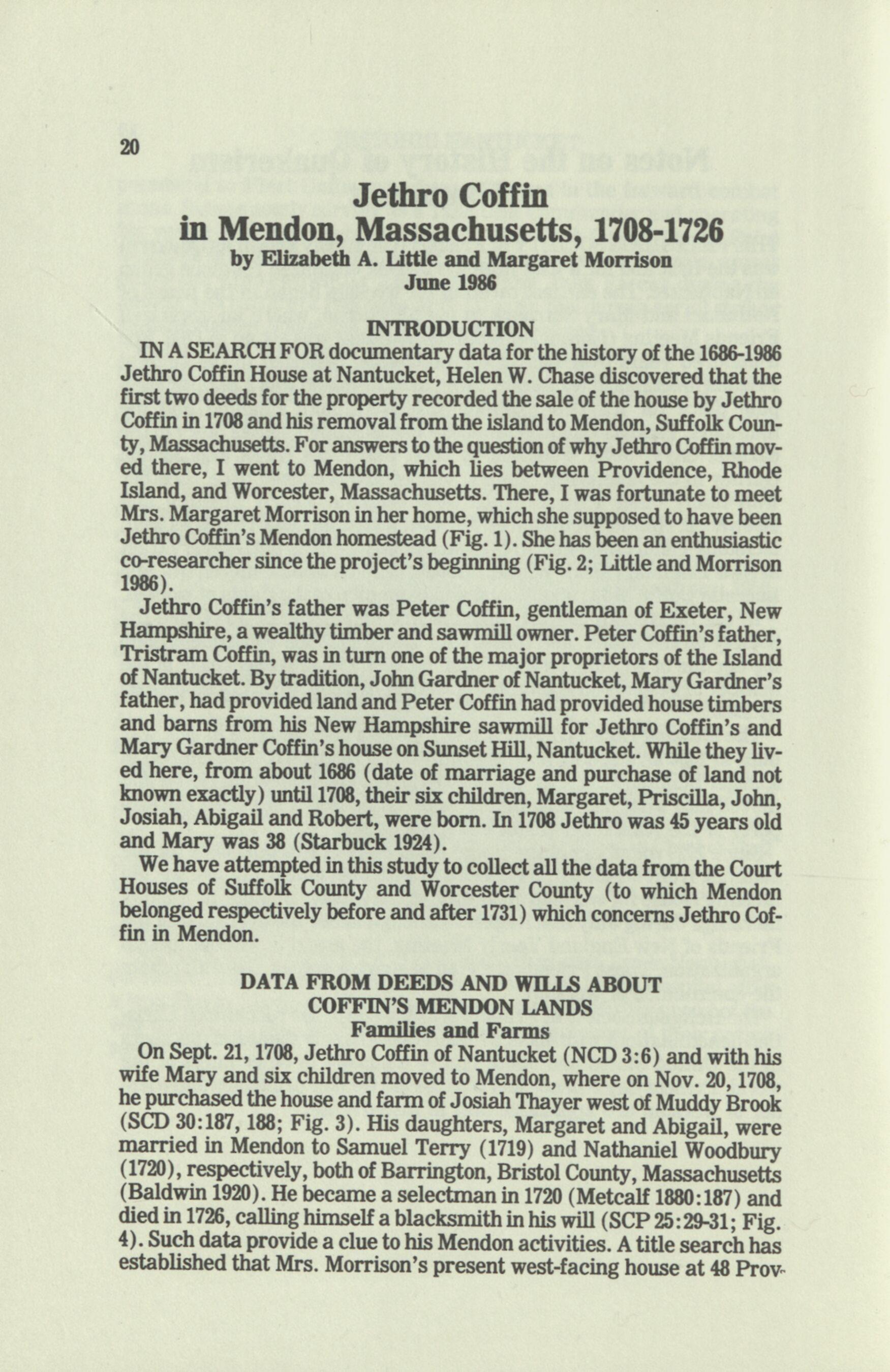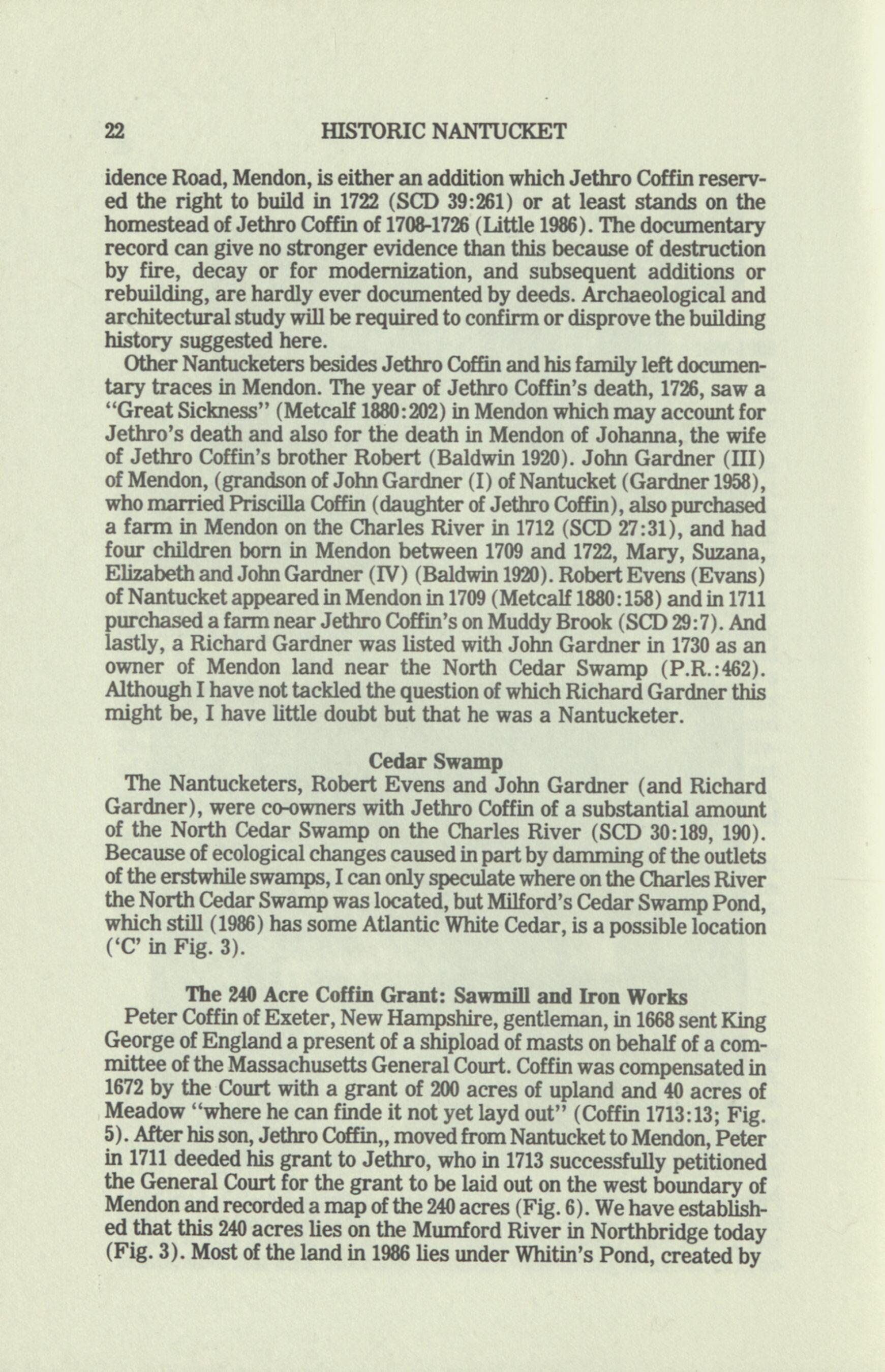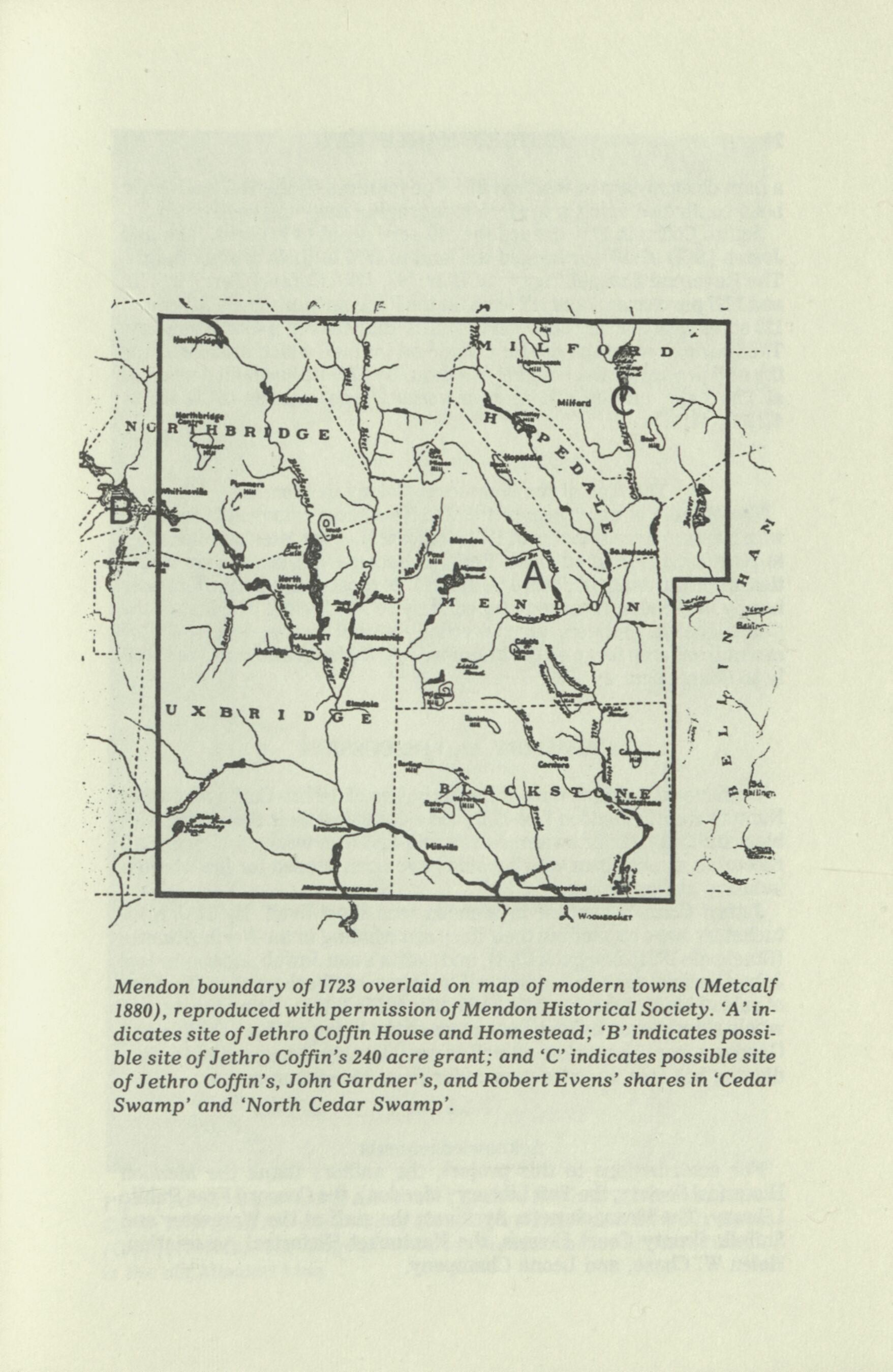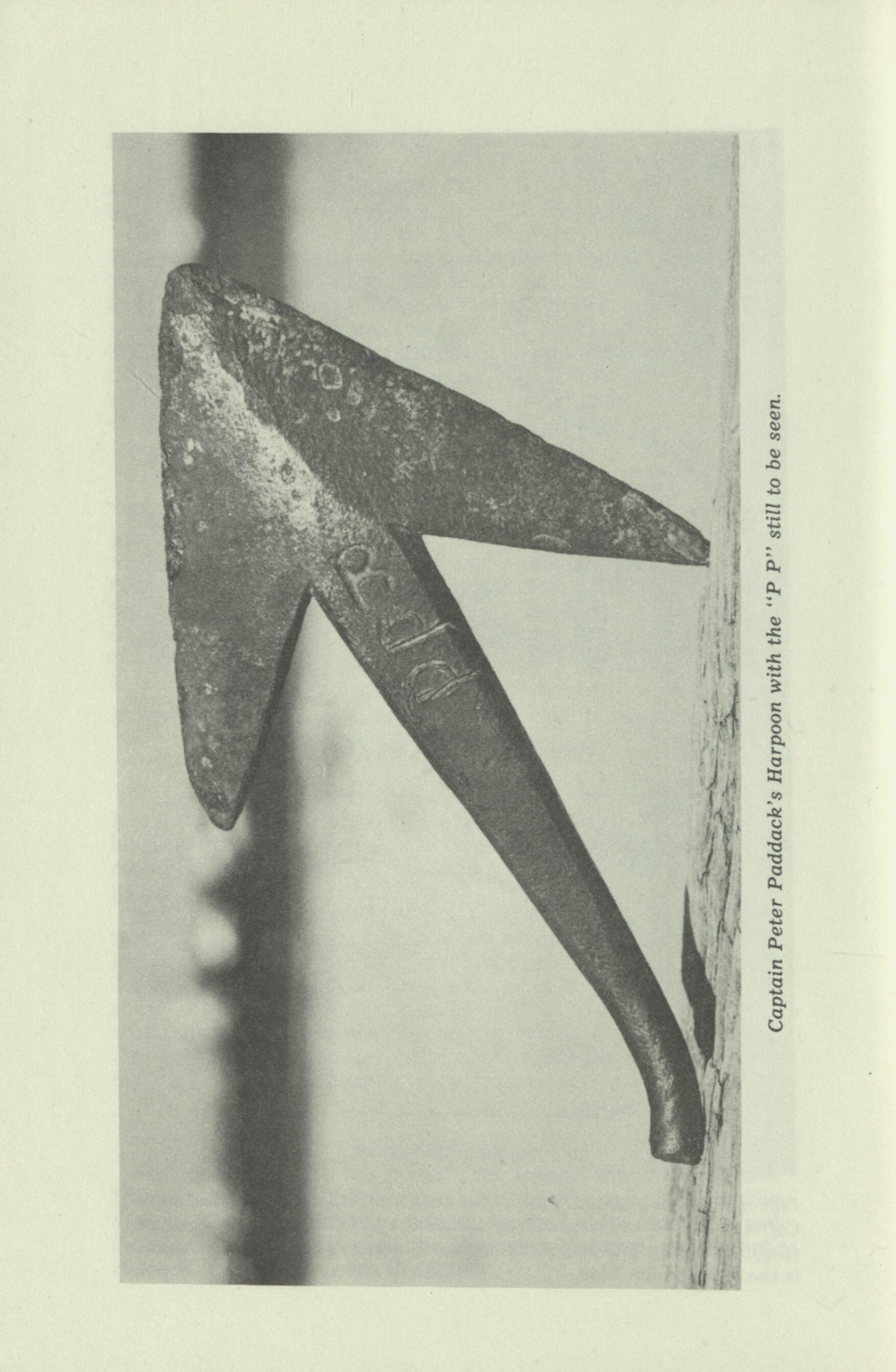
7 minute read
by Elizabeth A. Little and Margaret Morrison
20
Jethro Coffin in Mendon, Massachusetts, 1708-1726
by Elizabeth A. Little and Margaret Morrison June 1986
INTRODUCTION
IN A SEARCH FOR documentary data for the history of the 1686-1986 Jethro Coffin House at Nantucket, Helen W. Chase discovered that the first two deeds for the property recorded the sale of the house by Jethro Coffin in 1708 and his removal from the island to Mendon, Suffolk County, Massachusetts. For answers to the question of why Jethro Coffin moved there, I went to Mendon, which Ues between Providence, Rhode Island, and Worcester, Massachusetts. There, I was fortunate to meet Mrs. Margaret Morrison in her home, which she supposed to have been Jethro Coffin's Mendon homestead (Fig. 1). She has been an enthusiastic co-researcher since the project's beginning (Fig. 2; Little and Morrison 1986).
Jethro Coffin's father was Peter Coffin, gentleman of Exeter, New Hampshire, a wealthy timber and sawmill owner. Peter Coffin's father, Tristram Coffin, was in turn one of the major proprietors of the Island of Nantucket. By tradition, John Gardner of Nantucket, Mary Gardner's father, had provided land and Peter Coffin had provided house timbers and barns from his New Hampshire sawmill for Jethro Coffin's and Mary Gardner Coffin's house on Sunset Hill, Nantucket. While they lived here, from about 1686 (date of marriage and purchase of land not known exactly) until 1708, their six children, Margaret, Priscilla, John, Josiah, Abigail and Robert, were born. In 1708 Jethro was 45 years old and Mary was 38 (Starbuck 1924).
We have attempted in this study to collect all the data from the Court Houses of Suffolk County and Worcester County (to which Mendon belonged respectively before and after 1731) which concerns Jethro Coffin in Mendon.
DATA FROM DEEDS AND WILLS ABOUT COFFIN'S MENDON LANDS Families and Farms
On Sept. 21,1708, Jethro Coffin of Nantucket (NCD 3:6) and with his wife Mary and six children moved to Mendon, where on Nov. 20,1708, he purchased the house and farm of Josiah Thayer west of Muddy Brook (SCD 30:187,188; Fig. 3). His daughters, Margaret and Abigail, were married in Mendon to Samuel Terry (1719) and Nathaniel Woodbury (1720), respectively, both of Barrington, Bristol County, Massachusetts (Baldwin 1920). He became a selectman in 1720 (Metcalf 1880:187) and died in 1726, calling himself a blacksmith in his will (SCP 25:29-31; Fig. 4). Such data provide a clue to his Mendon activities. A title search has established that Mrs. Morrison's present west-facing house at 48 Prov-
Photograph of Mrs. Francis Morrison's house, 48 Providence Road, Mendon, MA 01756, in 1985, looking east from Providence Road.
Photograph of Mrs. Francis Morrison (right) and her daughter-in-law, Rita Paddack, at the Jethro Coffin House, Nantucket in 1985.

22
HISTORIC NANTUCKET
idence Road, Mendon, is either an addition which Jethro Coffin reserved the right to build in 1722 (SCD 39:261) or at least stands on the homestead of Jethro Coffin of 1708-1726 (Little 1986). The documentary record can give no stronger evidence than this because of destruction by fire, decay or for modernization, and subsequent additions or rebuilding, are hardly ever documented by deeds. Archaeological and architectural study will be required to confirm or disprove the building history suggested here.
Other Nantucketers besides Jethro Coffin and his family left documentary traces in Mendon. The year of Jethro Coffin's death, 1726, saw a "Great Sickness" (Metcalf 1880:202) in Mendon which may account for Jethro's death and also for the death in Mendon of Johanna, the wife of Jethro Coffin's brother Robert (Baldwin 1920). John Gardner (III) of Mendon, (grandson of John Gardner (I) of Nantucket (Gardner 1958), who married Priscilla Coffin (daughter of Jethro Coffin), also purchased a farm in Mendon on the Charles River in 1712 (SCD 27:31), and had four children born in Mendon between 1709 and 1722, Mary, Suzana, Elizabeth and John Gardner (IV) (Baldwin 1920). Robert Evens (Evans) of Nantucket appeared in Mendon in 1709 (Metcalf 1880:158) and in 1711 purchased a farm near Jethro Coffin's on Muddy Brook (SCD 29:7). And lastly, a Richard Gardner was listed with John Gardner in 1730 as an owner of Mendon land near the North Cedar Swamp (P.R.:462). Although I have not tackled the question of which Richard Gardner this might be, I have little doubt but that he was a Nantucketer.

Cedar Swamp
The Nantucketers, Robert Evens and John Gardner (and Richard Gardner), were co-owners with Jethro Coffin of a substantial amount of the North Cedar Swamp on the Charles River (SCD 30:189, 190). Because of ecological changes caused in part by damming of the outlets of the erstwhile swamps, I can only speculate where on the Charles River the North Cedar Swamp was located, but Milford's Cedar Swamp Pond, which still (1986) has some Atlantic White Cedar, is a possible location ('C' in Fig. 3).
The 240 Acre Coffin Grant: Sawmill and Iron Works
Peter Coffin of Exeter, New Hampshire, gentleman, in 1668 sent King George of England a present of a shipload of masts on behalf of a committee of the Massachusetts General Court. Coffin was compensated in 1672 by the Court with a grant of 200 acres of upland and 40 acres of Meadow "where he can finde it not yet layd out" (Coffin 1713:13; Fig. 5). After his son, Jethro Coffin,, moved from Nantucket to Mendon, Peter in 1711 deeded his grant to Jethro, who in 1713 successfully petitioned the General Court for the grant to be laid out on the west boundary of Mendon and recorded a map of the 240 acres (Fig. 6). We have established that this 240 acres lies on the Mumford River in Northbridge today (Fig. 3). Most of the land in 1986 lies under Whitin's Pond, created by
Mendon boundary of 1723 overlaid on map of modern towns (Metcalf 1880), reproduced with permission of Mendon Historical Society. 'A' indicates site ofJethro Coffin House and Homestead; 'B' indicates possible site of Jethro Coffin's 240 acre grant; and 'C' indicates possible site ofJethro Coffin's, John Gardner's, and Robert Evens' shares in 'Cedar Swamp' and 'North Cedar Swamp'.

24 HISTORIC NANTUCKET
a dam downstream in Whitinsville. The features on the 1713 map have been confirmed using a modern topographic map and field checks.
Jethro Coffin in 1715 deeded the 240 acre grant to his sons John and Josiah (SCD 29:180), who sold the land in 1726 to their brother-in-law, The Reverend Samuel Terry (SCD 39:197,198). Samuel Terry in 1726 and 1727 purchased 4 and 1/2 acres at the Falls on Mumford's River and 120 acres with housing between the Falls and Mendon's west boundary. Thus he now owned the site for a dam and the land which would become the mill pond after the building of a dam. By 1727 he had built a sawmill at The Falls, and by 1728 an iron works (forge) nearby (SCD 43:26; 42:238; 43:147).
The End of the Nantucket Colony at Mendon
The number of marriages within the Nantucket colony at Mendon or with Nantucketers (Starbuck, 1924) indicate that the Mendon colony ties to Nantucket remained close. Perhaps because of these strong island ties, after the death of Jethro Coffin in 1726 most of the Coffin/Gardner family in Mendon returned immediately to Nantucket. The last of the Coffin clan in Mendon, the Reverend Samuel Terry, developed the sawmill and iron forge on the Mumford by 1728 before moving his family to Connecticut by 1737.

SUMMARY AND DISCUSSION
We have collected details of the activities of Jethro Coffin and other Nantucketers in Mendon 1708-1737, and established their connection with blacksmithing, cedar swamp, a sawmill and iron works, which are all resources or activities which would have been needed for the whaling industry at Nantucket.
Jethro Coffin's venture in Mendon was short-lived. By 1737 Nantucketers were expanding their deep sea whaling in the North Atlantic (Stackpole 1953; Starbuck 1924), and Coffin's son Josiah and son-in-law John Gardner each called himself 'mariner of Sherbourn' on the deed of sale of his Mendon land (SCD 39:197; WCD 3:116). Being masters of whale ships seems to have been more to the liking of these Coffins and Gardners from Nantucket, as well as considerably more profitable, than digging bog iron or extracting cedar from Mendon swamps.
Acknowledgements
For contributions to this project, the authors thank the Mendon Historical Society, the Taft Library (Mendon), the Concord Free Public Library, The Massachusetts Archives, the staff at the Worcester and Suffolk County Court Houses, the Nantucket Historical Association, Helen W. Chase, and Leona Champeny.










